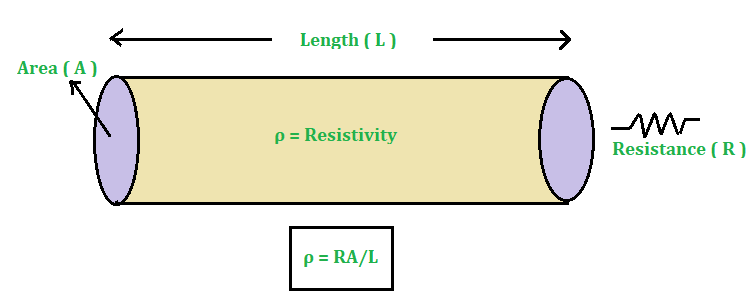导体具有大量的自由电子。当在导体的两端之间施加电势差时,自由电子从导体的一端移动到另一端。当电子漂移或移动时,它们与导体的原子(离子)发生碰撞。这些碰撞与自由电子从导体的一端到另一端的运动相反。由于与导体中离子的碰撞而与自由电子流产生的这种相反作用称为导体的电阻。电子在导体中遭受的碰撞越多,导体提供的电阻就越大。
什么是欧姆定律?
乔治·西蒙·欧姆(George Simon Ohm)(德国物理学家)1826年研究了电流与导体两端电位差之间的关系。电流与电位差之间的关系称为欧姆定律。
该定律指出,只要导体的温度和其他物理条件保持不变,在导体中流动的电流就与跨导体两端的电势差成正比。
Mathematically, this law can be stated as,
Electric current (I) ∝ Potential difference (V)
⇒ I ∝ V
or
V ∝ I
⇒ V = I × R
where, R is the constant of proportionality and is known as the resistance of the conductor.
因此,欧姆定律可以表示为 如果导体的温度和其他物理条件保持不变,则导体两端的电位差与流过该导体的电流之比将保持恒定。
V和I之间的图形是一条穿过原点的直线,如下图所示:

VI图
抵抗性
在电路中,电阻是对电流的电阻的量度。希腊字母omega(Ω)用于表示电阻(以欧姆为单位)。乔姆·西蒙·欧姆(Georg Simon Ohm,1784-1854年)是德国物理学家,他研究了电压,电流和电阻之间的关系,是欧姆的名字。据说欧姆定律是他制定的。
To an extent, all materials resist current flow. They are divided into two groups: Conductors and Insulators.
- Materials with low resistance that allow electrons to travel freely are termed, Conductors.
e.g.: Silver, copper, gold, and aluminum.
- High-resistance materials that prevent electrons from flowing freely are termed Insulators.
e.g.: Rubber, paper, glass, wood, and plastic.
电阻测量通常用于确定组件或电路的状态,如下所示:
- 电流越低,电阻越高。如果电压异常高,则由于燃烧或腐蚀而造成的导体损坏可能是一种(许多)潜在原因。由于所有导体都会散发一些热量,因此过热是一个经常与电阻相关的问题。
- 电流输出越高,电阻越小。绝缘体受潮或过热是两个可能的原因。
Mathematically, the Resistance of a conductor can be evaluated by using Ohm’s Law as:
According to Ohm’s Law,
V = I × R
Rearrange the above expression for R as,
R = V / I
Hence, the resistance of a conductor is defined as the ratio of the voltage and the current flow through the conductor.
因此,电阻的单位可以确定为:
R = V / I = 1伏(V)/ 1安培(A)
= 1 V / 1 A
= 1欧姆(Ω)
因此,电阻的单位是欧姆(Ω) 。
影响抵抗的因素
让我们进行一个实验来研究导体电阻所依赖的因素。如下图所示,将各种电气组件连接起来:

在此,电阻R通过电压源V跨接在两端A和B上。电路处于接通模式,作为键,K插入。因此,电流在电流表A所示的电路中流动。以下是导体电阻所依赖的因素:
1.导体的长度:考虑一根长度为1 m的铜线,并将其连接在电路的端子A和B之间。注意电流表的读数。现在,使用另一根横截面积相同但长度为2 m的铜线。通过断开先前的电线将其连接在端子A和B之间。再次注意电流表的读数。可以发现,第二种情况下的电流表读数(即电流)是第一种情况下的电流表读数的一半。
- 由于I = V / R,因此第二根导线的电阻是第一根导线的电阻的两倍。
- 它表明导体的电阻与导体的长度成正比。
- 因此,导体的长度越大,其电阻就越大。
2.导体的横截面积:现在,取两条长度相同但横截面积不同的铜线。令第一线材的横截面面积大于第二线材的横截面面积。在上图所示的电路中,将第一根导线连接在端子A和B之间。注意电流表的读数。现在断开第一根导线,然后将第二根导线连接在端子A和B之间。再次注意电流表的读数。可以发现,当第一线(即粗线)连接在A和B之间时,电流表的读数要比第二线(即细线)时的电流表读数大。连接在端子A和B之间。
- 它表明导体的电阻与导体的横截面积成反比。
- 因此,细线的电阻大于粗线的电阻。
3.材料性质的影响:取两条相同的线,一根为铜线,另一根为铝线。将铜线连接在端子A和B之间。注意电流表的读数。现在,在端子A和B之间连接铝线。再次注意电流表的读数。发现在电路中连接铜线时电流表的读数大于在电路中连接铝线时电流表的读数。
- 这意味着铜线的电阻小于铝线的电阻。
- 因此,导线或导体的电阻取决于导体材料的性质。
4.导体温度的影响:如果电路中连接的导体的温度升高,则其电阻会增加。
Conclusion:
Thus, factors on which resistance of a conductor depends are:
(i) its length (l),
(ii) Area of the cross-section (A),
(iii) the nature of its material and
(iv) its temperature.
电阻率或比电阻
通过实验发现,导体的电阻为:
- Directly proportional to its length (l) or R ∝ l.
- Inversely proportional to its area of cross-section (A) or R ∝ 1/A.

Let’s combine these two conditions for the resistance as
R ∝ l / A
or
R = ρ × l / A
where ρ is the constant of proportionality and known as the Resistivity or Specific Resistance of the conductor.
Rearrange the above expression for ρ,
ρ = R × A / l
- 因此,导体的电阻率被定义为单位长度和横截面的单位面积的导体的电阻。
- 换句话说,导体的电阻率称为由1 m侧的4个立方导体提供的电阻,该电流对流经该导体相对面的电流的抵抗。
- 在CGS系统中,电阻率或电阻率的单位为ohm-cm(Ω-cm) 。
- 在SI中,电阻率或比电阻的单位是欧姆表(Ω-m)。
为了进一步了解电阻率的概念和公式,我们来看一个示例:
示例:引出电阻为20欧姆的导体,以使其长度增加到其原始长度的两倍。计算新导线的电阻。
解决方案:
Given that,
The resistance of the conductor, R is 20 Ω.
If original length of the conductor is l then new length (l’) of the conductor is 2l.
So, if the original cross-sectional area is A and new cross-sectional area is A’, then:
Since, l’ = 2l therefore A’ = A / 2.
In case of the original conductor, original resistance is:
R = ρ × l / A
20 Ω = ρ × l / A …… (1)
Now, in case of the new conductor, new resistance is:
R’ = ρ × l’ / A’
= (ρ × 2l) / (A / 2)
= (4 × ρ × l) / A
Use equation (1) in the above expression and solve to calculate R’.
R’ = 4 × 20 Ω
= 80 Ω
Hence, the resistance of the new wire is 80 Ω.
样本问题
问题1:如果流过导体的电流为0.3 A,施加的电势差为0.9伏,则求出导体的电阻。
解决方案:
Given that,
The current flow, I is 0.3 A.
The applied potential difference, V is 0.9 V.
Now, use the formula:
R = V / I
= 0.9 V / 0.3 A
= 3 Ω
Hence, the resistance of a conductor is 3 Ω.
问题2:加热器的电阻为50,并连接到220伏电源,计算加热器中的电流。
解决方案:
Given that,
The resistance of the heater, R is 50 Ω.
The potential difference, V is 220 V.
Now, use the formula:
V = I × R
Rearrange the above expression for I as,
I = V / R
= 220 V / 50 Ω
= 4.4 A
Hence, the current in the heater is 4.4 A.
问题3:铁的电阻率和汞由10.0×10 -8和94×10 -8Ω.cm分别给出。哪个导体更好?
解决方案:
A material whose resistivity is low is consider as good conductor of electricity.
Hence, Iron is the good conductor than Mercury.
问题4:定义1欧姆电阻。
解决方案:
Resistance of a conductor is said to be 1 ohm if a potential difference of 1 volt across the ends of the conductor makes a current of 1 ampere to pass through it.
问题5:让电子元件的电阻保持恒定,而元件两端的电势差减小到以前值的一半。通过它的电流会发生什么变化?
解决方案:
Since, I = V / R, when V’=V / 2
I’ = V / 2R = I / 2
Thus, the current in the components becomes half of its former value.